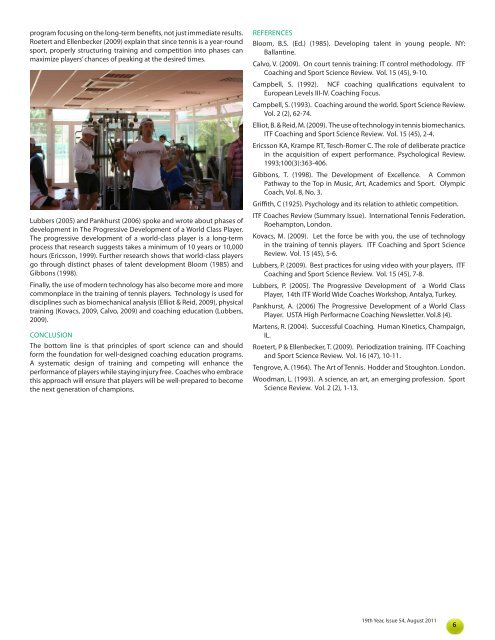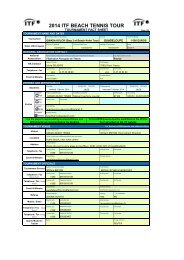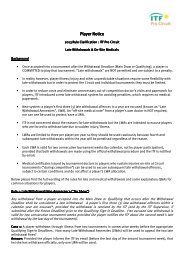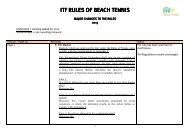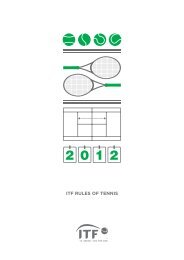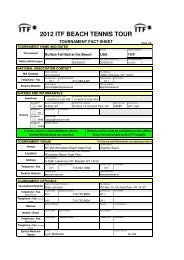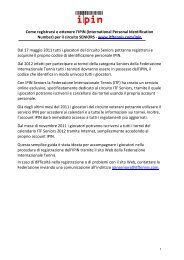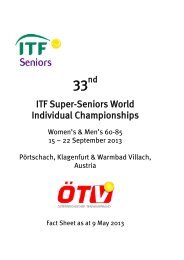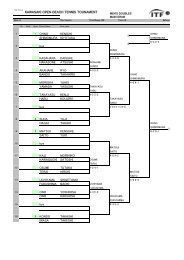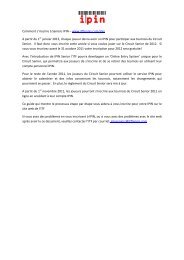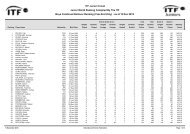Coaching & Sport Science Review - International Tennis Federation
Coaching & Sport Science Review - International Tennis Federation
Coaching & Sport Science Review - International Tennis Federation
Create successful ePaper yourself
Turn your PDF publications into a flip-book with our unique Google optimized e-Paper software.
program focusing on the long-term benefits, not just immediate results.<br />
Roetert and Ellenbecker (2009) explain that since tennis is a year-round<br />
sport, properly structuring training and competition into phases can<br />
maximize players’ chances of peaking at the desired times.<br />
Lubbers (2005) and Pankhurst (2006) spoke and wrote about phases of<br />
development in The Progressive Development of a World Class Player.<br />
The progressive development of a world-class player is a long-term<br />
process that research suggests takes a minimum of 10 years or 10,000<br />
hours (Ericsson, 1999). Further research shows that world-class players<br />
go through distinct phases of talent development Bloom (1985) and<br />
Gibbons (1998).<br />
Finally, the use of modern technology has also become more and more<br />
commonplace in the training of tennis players. Technology is used for<br />
disciplines such as biomechanical analysis (Elliot & Reid, 2009), physical<br />
training (Kovacs, 2009, Calvo, 2009) and coaching education (Lubbers,<br />
2009).<br />
CONCLUSION<br />
The bottom line is that principles of sport science can and should<br />
form the foundation for well-designed coaching education programs.<br />
A systematic design of training and competing will enhance the<br />
performance of players while staying injury free. Coaches who embrace<br />
this approach will ensure that players will be well-prepared to become<br />
the next generation of champions.<br />
REFERENCES<br />
Bloom, B.S. (Ed.) (1985). Developing talent in young people. NY:<br />
Ballantine.<br />
Calvo, V. (2009). On court tennis training: IT control methodology. ITF<br />
<strong>Coaching</strong> and <strong>Sport</strong> <strong>Science</strong> <strong>Review</strong>. Vol. 15 (45), 9-10.<br />
Campbell, S. (1992). NCF coaching qualifications equivalent to<br />
European Levels III-IV. <strong>Coaching</strong> Focus.<br />
Campbell, S. (1993). <strong>Coaching</strong> around the world. <strong>Sport</strong> <strong>Science</strong> <strong>Review</strong>.<br />
Vol. 2 (2), 62-74.<br />
Elliot, B. & Reid, M. (2009). The use of technology in tennis biomechanics.<br />
ITF <strong>Coaching</strong> and <strong>Sport</strong> <strong>Science</strong> <strong>Review</strong>. Vol. 15 (45), 2-4.<br />
Ericsson KA, Krampe RT, Tesch-Romer C. The role of deliberate practice<br />
in the acquisition of expert performance. Psychological <strong>Review</strong>.<br />
1993;100(3):363-406.<br />
Gibbons, T. (1998). The Development of Excellence. A Common<br />
Pathway to the Top in Music, Art, Academics and <strong>Sport</strong>. Olympic<br />
Coach, Vol. 8, No. 3.<br />
Griffith, C (1925). Psychology and its relation to athletic competition.<br />
ITF Coaches <strong>Review</strong> (Summary Issue). <strong>International</strong> <strong>Tennis</strong> <strong>Federation</strong>.<br />
Roehampton, London.<br />
Kovacs, M. (2009). Let the force be with you, the use of technology<br />
in the training of tennis players. ITF <strong>Coaching</strong> and <strong>Sport</strong> <strong>Science</strong><br />
<strong>Review</strong>. Vol. 15 (45), 5-6.<br />
Lubbers, P. (2009). Best practices for using video with your players. ITF<br />
<strong>Coaching</strong> and <strong>Sport</strong> <strong>Science</strong> <strong>Review</strong>. Vol. 15 (45), 7-8.<br />
Lubbers, P. (2005). The Progressive Development of a World Class<br />
Player, 14th ITF World Wide Coaches Workshop, Antalya, Turkey.<br />
Pankhurst, A. (2006) The Progressive Development of a World Class<br />
Player. USTA High Performacne <strong>Coaching</strong> Newsletter. Vol.8 (4).<br />
Martens, R. (2004). Successful <strong>Coaching</strong>. Human Kinetics, Champaign,<br />
IL.<br />
Roetert, P & Ellenbecker, T. (2009). Periodization training. ITF <strong>Coaching</strong><br />
and <strong>Sport</strong> <strong>Science</strong> <strong>Review</strong>. Vol. 16 (47), 10-11.<br />
Tengrove, A. (1964). The Art of <strong>Tennis</strong>. Hodder and Stoughton. London.<br />
Woodman, L. (1993). A science, an art, an emerging profession. <strong>Sport</strong><br />
<strong>Science</strong> <strong>Review</strong>. Vol. 2 (2), 1-13.<br />
19th Year, Issue 54, August 2011<br />
6


